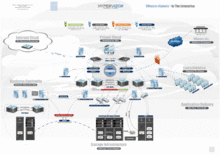VMware vSphere
| Developer(s) | VMware |
|---|---|
| Stable release |
6.0
|
| License | Proprietary |
| Website |
vmware |
VMware vSphere (formerly VMware Infrastructure 4) is VMware's cloud computing virtualization platform.[1]
History

While developing VMware Infrastructure 3.5, VMware conceived vSphere as an enhanced suite of tools for cloud computing utilizing VMware ESX/ESXi 4.[2]
VMware spun off the cloud computing-enabled tool suite as VMware Infrastructure 4 (VI 4 for short) to be distinct from VMware Infrastructure 3.5 (VI 3.5) that was then ready for release (March 30, 2009).[2]
On April 21, 2009, VMware announced vSphere 4, instead of VI 4, releasing it on May 21, 2009.[2]
On November 19, 2009, VMware released Update 1 for vSphere 4, adding support for Windows 7 and Windows Server 2008 R2.[3]
VMware's vSphere 4.1 began shipping in August 2010. This update included an updated vCenter Configuration Manager, as well as vCenter Application Discovery Manager, and the ability of vMotion to move more than one virtual machine at a time from one server host to another.
On 10 February 2011 VMware released Update 1 for vSphere 4.1 to add support for RHEL 6, RHEL 5.6, SLES 11 SP1 for VMware, Ubuntu 10.10, and Solaris 10 Update 9.[4]
On July 12, 2011, VMware released version 5 of VMware vSphere.[5]
On August 27, 2012, VMware released vSphere 5.1. This extended vSphere to include VMware vSphere Storage Appliance, vSphere Data Protection, vSphere Replication and vShield Endpoint.[6]
September 22, 2013, saw the release of vSphere 5.5.
On May 2014 SAP and VMWare announced the availability of SAP HANA for production use on VMware vSphere 5.5 [7]
On February 3, 2015, VMware's CEO Pat Gelsinger announced vSphere 6.0 with a large number of new features and enhancements.[8]
See also
- VMware ESX/ESXi, the hypervisor operating system component
- VMware VMFS, the VMware file system component
Reference list
- ↑ "Server Virtualization with VMware vSphere | VMware India". www.vmware.com. Retrieved 2016-03-08.
- 1 2 3 Release article. Retrieved from http://vsphere-land.com/news/vsphere-release-date.html.
- ↑ "VMware ESX 4.0 Update 1 Release Notes". December 18, 2009.
- ↑ "VMware ESX 4.1 Update 1 Release Notes". February 10, 2011.
- ↑ "VMware vSphere® 5 launched".
- ↑ "VMware vSphere® 5.1 Helps SMBs Simplify and Protect Their IT Environments with New Business Continuity and Management Capabilities".
- ↑ http://www.vmware.com/company/news/releases/vmw-newsfeed/SAP-and-VMware-Announce-SAP-HANA%C2%AE-for-Production-Use-on-VMware-vSphere-5.5/1837460#sthash.SJsM5ITw.dpuf
- ↑ "vSphere 6.0 finally announced!". February 3, 2015.
External links
- VMware Infrastructure product page - VMware, Inc.